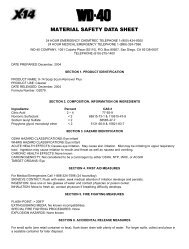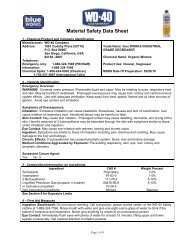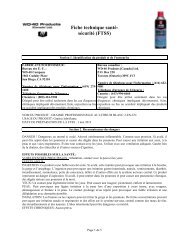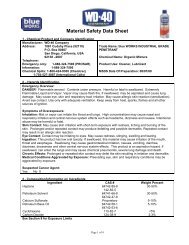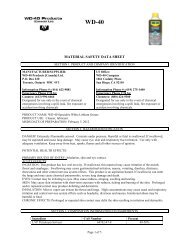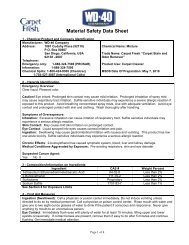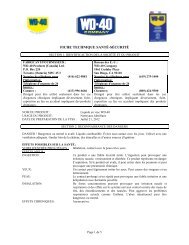Material Safety Data Sheet (MSDS) - WD-40
Material Safety Data Sheet (MSDS) - WD-40
Material Safety Data Sheet (MSDS) - WD-40
Create successful ePaper yourself
Turn your PDF publications into a flip-book with our unique Google optimized e-Paper software.
Skin Contact: Wash with soap and water. If irritation develops and persists, get medical attention.<br />
Inhalation (Breathing): If irritation is experienced, move to fresh air. Get medical attention if irritation or other<br />
symptoms develop and persist.<br />
5 – Fire Fighting Measures<br />
Extinguishing Media: Use water fog, dry chemical, carbon dioxide or foam. Do not use water jet or flooding<br />
amounts of water. Burning product will float on the surface and spread fire.<br />
Special Fire Fighting Procedures: Firefighters should always wear positive pressure self-contained<br />
breathing apparatus and full protective clothing. Cool fire-exposed containers with water.<br />
Unusual Fire and Explosion Hazards: Combustible liquid and vapor. Vapors are heavier than air and may<br />
travel along surfaces to remote ignition sources and flash back.<br />
6 – Accidental Release Measures<br />
Wear appropriate protective clothing (see Section 8). Eliminate all sources of ignition and ventilate area.<br />
Contain and collect liquid with an inert absorbent and place in a container for disposal. Clean spill area<br />
thoroughly. Report spills to authorities as required.<br />
7 – Handling and Storage<br />
Handling: Avoid contact with eyes. Avoid prolonged contact with skin. Avoid breathing vapors or aerosols.<br />
Use with adequate ventilation. Keep away from heat, sparks, hot surfaces and open flames. Wash thoroughly<br />
with soap and water after handling. Keep containers closed when not in use. Keep out of the reach of<br />
children.<br />
Storage: Store in a cool, well-ventilated area, away from incompatible materials. NFPA 30 Class II Liquid.<br />
8 – Exposure Controls/Personal Protection<br />
Chemical<br />
Occupational Exposure Limits<br />
Aliphatic Hydrocarbon<br />
Petroleum Base Oil<br />
LVP Aliphatic Hydrocarbon<br />
Non-Hazardous Ingredients<br />
100 ppm TWA (ACGIH)<br />
1200 mg/m3 TWA (manufacturer recommended)<br />
5 mg/m3 TWA, 10 mg/m3 STEL ACGIH TLV<br />
5 mg/m3 TWA OSHA PEL<br />
1200 mg/m3 TWA (manufacturer recommended)<br />
None Established<br />
The Following Controls are Recommended for Normal Consumer Use of this Product<br />
Engineering Controls: Use in a well-ventilated area.<br />
Personal Protection:<br />
Eye Protection: Avoid eye contact. <strong>Safety</strong> glasses or goggles recommended.<br />
Skin Protection: Avoid prolonged skin contact. Chemical resistant gloves recommended for operations<br />
where skin contact is likely.<br />
Respiratory Protection: None needed for normal use with adequate ventilation.<br />
For Bulk Processing or Workplace Use the Following Controls are Recommended<br />
Engineering Controls: Use adequate general and local exhaust ventilation to maintain exposure levels<br />
below that occupational exposure limits.<br />
Personal Protection:<br />
Eye Protection: <strong>Safety</strong> goggles recommended where eye contact is possible.<br />
Skin Protection: Wear chemical resistant gloves.<br />
Respiratory Protection: None required if ventilation is adequate. If the occupational exposure limits are<br />
exceeded, wear a NIOSH approved respirator. Respirator selection and use should be based on contaminant<br />
type, form and concentration. Follow OSHA 1910.134, ANSI Z88.2 and good Industrial Hygiene practice.<br />
Work/Hygiene Practices: Wash with soap and water after handling.<br />
Page 2 of 4



